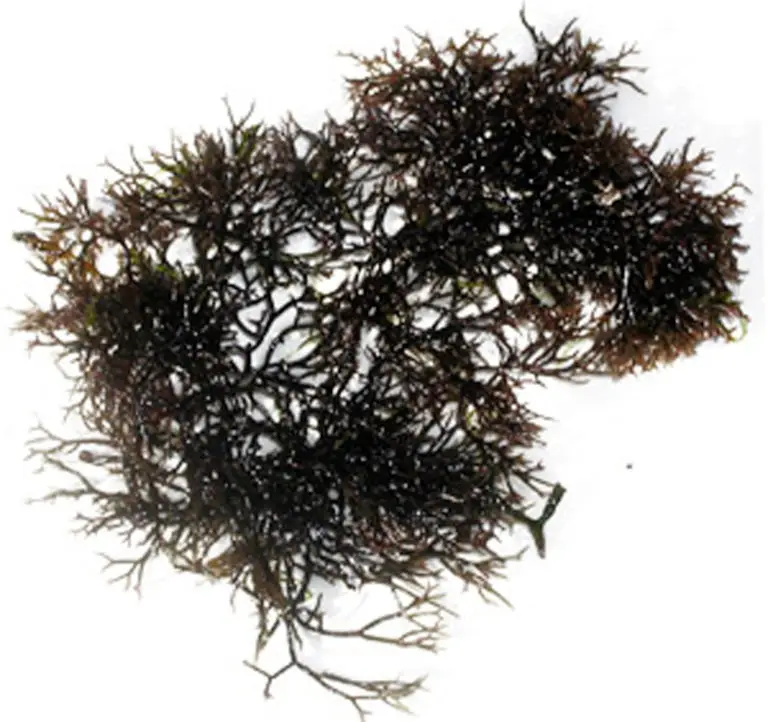Seaweed: Gracilaria

Table of Contents
Share This
Chaguan tasi (Red seaweed)
The notoriety of the red seaweed, Gracilaria tsudae, (Division Rhodophyta, Class Rhodophyceae, Order Gracilariales, Family Gracilariaceae), known as chaguan tasi on Guam, was triggered by the death of three Guam residents who ate the seaweed in April 1991.
The seaweed had been gathered from the reef flats of Tanguisson on the west coast of Guam and was sold at the local flea market. Besides the seven patients treated at the Guam Memorial Hospital, private practitioners treated two people and four minimally affected people did not seek medical care. All had ingested the same batch of seaweed. Two previously fatal poisonings from the ingestion of Japanese species of Gracilaria (Rom), G. chorda, and G. verrucosa, occurred in Sakata in 1980 and in Tokyo in 1982, respectively.
Graciliaria tsudae (Abbott & Meneses) Abbott was initially described in 1987 as Polycavernosa tsudae based on specimens collected from Saipan, Guam, and Yap. Four years later, the species was transferred to the genus Gracilaria. The names Gracilaria edulis (= Gracilaria lichenoides) and Gracilaria coronopifolia have been used interchangeably, but mistakenly, in past publications to describe this species on Guam. Gracilaria tsudae is documented only from the west coast of Guam, i.e., Tanguisson, Tumon Bay, Nimitz Channel, Sella Bay and Fouha Bay.
Both local residents and Japanese tourists are familiar with chaguan tsai and ogonori, respectively, as a desirable and edible seaweed. Gracilaria contains agar, a colloid (gelatin), used in commercial food preservation and as a microbiological growth media.
Initially, the causal agent for the food poisoning on Guam was mistakenly thought to be palytoxin since the zoanthid Palythoa tuberculosa was also present on the Tanguisson reef flat. The leaking oil from the grounds of the adjacent Tanguisson Power Plant and the release of sewage via the Northern District Sewage Outfall at a depth of 18 meters just north of the seaweed site were considered by the Guam Environmental Protection Agency.
However, these two factors do not seem to be the direct cause for the toxic seaweed. Specimens of Gracilaria tsudae from Sella Bay and Hågat were also reported to be toxic. Prostaglandins, a class of metabolic regulators, have been previously isolated from Australian Gracilaria edulis and from Japanese G. chorda and G. verrucosa, and were also considered as the possible toxin.
Toxin likely came from algae
Epiphytic cyanobacteria (blue-green algae) growing on the seaweed are now considered as the likely origin of the toxin, since the chemistry of the Gracilaria toxin seemed similar to toxins in cyanobacteria. Cyanobacteria were observed on the surface of toxic Gracilaria coronopifolia in Hawai’i.
Analysis by researchers at Tohoku University of G. tsudae collected from Tanguisson reef flat on May 2002 revealed a slight toxicity in the seaweed, that is, the injected mouse became sick but it recovered. In mid-May 2002, schools of juvenile herbivorous rabbitfish, Siganus spinus and Siganus argenteus, consumed the entire stand of G. tsudae from the reef flats of Tanguisson.
Further studies are needed to ascertain whether or not the toxin is being accumulated and concentrated in the fish. Tanguisson reef flats remain closed to fishers and collectors.
For further reading
Abbott, Isabella A., Zhang Junfu, and Xia Bangmei. “Gracilaria mixta, sp. nov. and Other Western Pacific Species of the Genus (Rhodophyta: Gracilariaceae).” Pacific Science 45, no.1 (1991): 12-27.
Barriault, Louis, Serge L. Boulet, Kenshu Fujiwara, Akio Murai, Leo A. Paquette, and Mari Yotsu-Yamashita. “Synthesis and Biological Evaluation of Analogs of the Marine Toxin Polycavernoside A.” Bioorganic & Medicinal Chemistry Letters 9, no. 14 (July 1999): 2069-2072.
Fujiwara, Kenshu, Akio Murai, Mari Yotsu-Yamashita, and Takeshi Yasumoto. “Total Synthesis and Absolute Configuration of Polycavernoside A.” Journal of the American Chemical Society 120, no. 41 (1998): 10770-10771.
Fusetani, Nobuhiro, and Kanehisa Hashimoto. “Prostaglandin E2: A Candidate for Causative Agent of ‘Ogonori’ Poisoning.” Nippon Suisan Gakkaishi 50, no. 3 (1984): 465-469.
Gregson, Richard P., John F. Marwood, and Ronald J. Quinn. “The Occurrence of Prostaglandins PGE2 and PGF2a in a Plant – the Red Alga Gracilaria Lichenoides.” Tetrahedron Letters 20, no. 46 (1979): 4505-4506.
Meneses, Isabel, and Isabella A. Abbott. “Gracilaria and Polycavernosa (Rhodophyta) from Micronesia.” Micronesica 20, (1987): 187-200.
Nelson, SG, and RN Tsutsui. “Browsing by Herbivorous Reef Fishes on the Agarophyte Gracilaria edulis (Rhodophyta) at Guam, Mariana Islands.” Fourth International Coral Reef Symposium. Manila, 18-22 May 1981.
Yotsu-Yamashita, Mari, Robert L. Haddock, and Takeshi Yasumoto. “Polycavernoside A: A Novel Glycosidic Macrolide from the Red Alga Polycavernosa tsudai (Gracilaria edulis).” Journal of the American Chemical Society 115, (1993): 1147-1148.
Yotsu-Yamashita, Mari, Tetsuya Seki, Valerie J. Paul, Hideo Naoki, and Takeshi Yasumoto. “Four New Analogs of Polycavernoside A.” Tetrahedron Letters 36, no. 31 (1995): 5563-5566.
